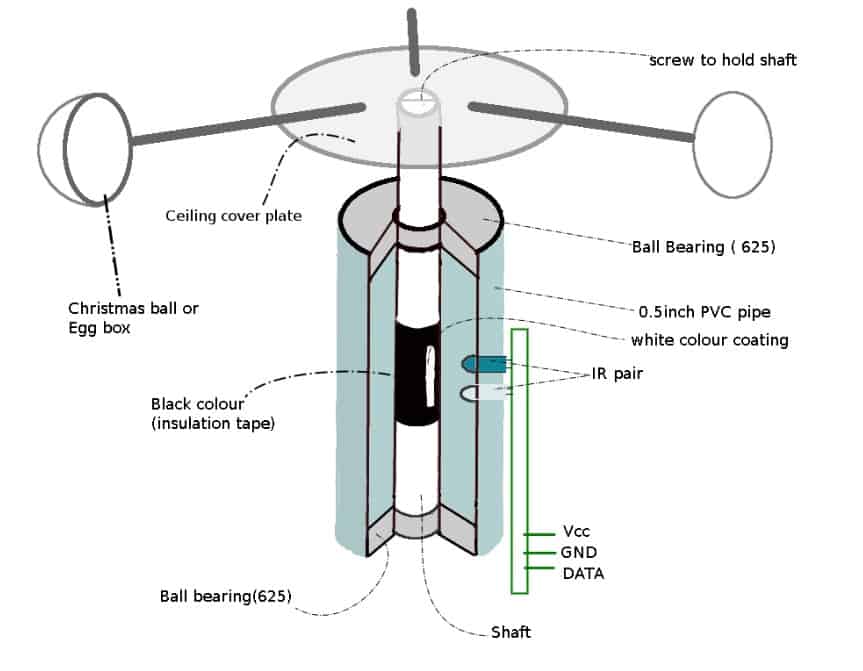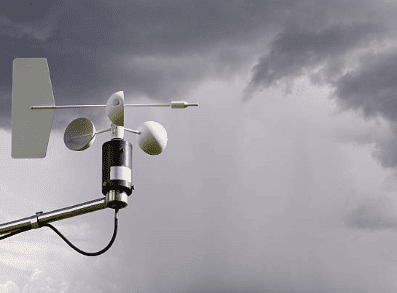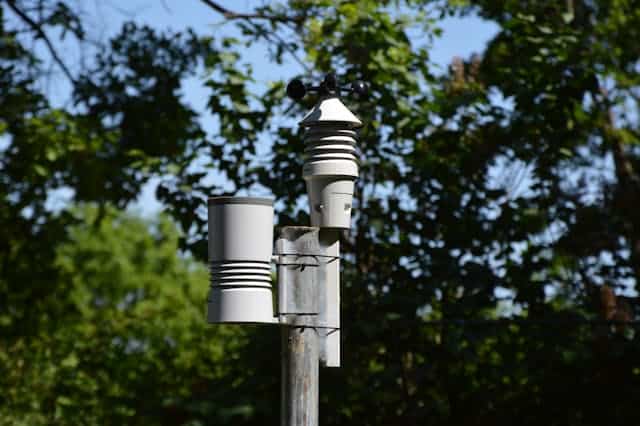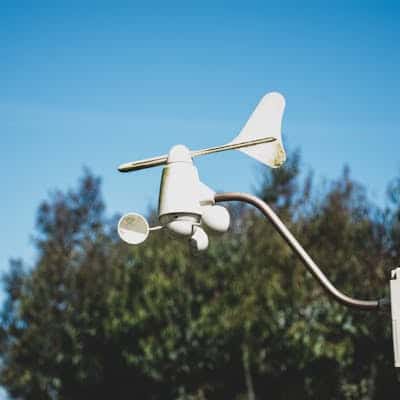Ever glanced at a weather forecast and wondered how meteorologists predict the weather with such accuracy? One of the key tools in their arsenal is the anemometer, a device that measures wind speed and direction.
But how exactly does an anemometer help forecast the weather? In this comprehensive blog post, we’ll unravel the mysteries behind weather prediction and explore the pivotal role that anemometers play in understanding atmospheric conditions.
What are Anemometers?
Anemometers are specialized devices used to measure wind speed and direction. They come in various forms, including cup, vane, and sonic anemometers, each tailored to specific applications and environments.
These instruments are widely employed in meteorology, aviation, environmental monitoring, and wind energy assessment.
What are the types of Anemometers?
Cup Anemometers: Cup anemometers, characterized by three or more cups mounted on horizontal arms, are among the most widely used types.
The cups rotate in response to the wind’s force, and the rotational speed is converted into wind speed readings. This design, first introduced by British meteorologist Thomas Romney Robinson in the 19th century, remains a cornerstone of wind measurement technology.
in the 19th century, remains a cornerstone of wind measurement technology.
Vane Anemometers: Vane anemometers, also known as wind vanes, focus primarily on determining wind direction. Consisting of a directional pointer connected to a tail, these instruments align themselves with the wind’s direction, providing valuable directional data.

Sonic Anemometers: Sonic anemometers represent a more advanced technology, utilizing ultrasonic waves to measure wind speed and direction.
These instruments employ pairs of ultrasonic transducers to transmit and receive signals, analyzing the time taken for signal propagation to calculate wind parameters accurately. Sonic anemometers offer high precision and are commonly used in research applications and specialized meteorological studies.
Hot-Wire Anemometers: Hot-wire anemometers, based on the principle of convective heat transfer, measure wind speed by monitoring changes in wire temperature as air flows past it.
This type of anemometer is highly sensitive and suitable for low-speed airflow measurements, making it valuable in industrial settings and boundary layer research.
Lidar (Light Detection and Ranging) Anemometers: Lidar anemometers utilize laser beams to detect and track aerosol particles carried by the wind.
By analyzing the motion of these particles, lidar systems can infer wind characteristics, offering non-contact and remote sensing capabilities ideal for atmospheric research and wind energy applications.
How Do Anemometers Work?
Anemometers operate based on various principles, each tailored to the specific type of instrument. Cup anemometers convert wind force into rotational motion, which is then translated into wind speed readings.
Vane anemometers rely on wind direction to orient themselves, providing directional information. Sonic anemometers measure wind speed and direction by analyzing the time taken for ultrasonic signals to propagate between transducers.
Hot-wire anemometers monitor changes in wire temperature caused by airflow, while lidar anemometers use laser technology to track particles and infer wind characteristics.

Importance of Anemometers in Weather Monitoring
The significance of anemometers in weather monitoring cannot be overstated. These instruments form the backbone of meteorological observation networks, providing crucial data for weather forecasting, severe weather detection, and climate research.
observation networks, providing crucial data for weather forecasting, severe weather detection, and climate research.
By accurately measuring wind speed and direction, anemometers enable meteorologists to anticipate weather patterns, issue timely warnings for hazardous conditions such as storms or hurricanes, and optimize renewable energy production from wind turbines.
Additionally, anemometer data contributes to our understanding of atmospheric dynamics, climate variability, and long-term climate trends, informing policy decisions and mitigation strategies for climate change.
Advancements in Anemometer Technology
Recent years have witnessed remarkable advancements in anemometer technology, driven by innovations in sensor design, data processing algorithms, and wireless communication capabilities.
Miniaturization has led to the development of compact and portable anemometers suitable for personal and mobile applications, expanding their utility beyond traditional meteorological stations.
Improved sensor accuracy and reliability have enhanced the precision of wind measurements, enabling more nuanced analyses of wind patterns and behaviors.
Integration with wireless communication technologies facilitates real-time data transmission and remote monitoring, empowering users to access and analyze wind data from virtually anywhere.
Furthermore, advancements in data processing algorithms have optimized the interpretation of anemometer data, extracting valuable insights and facilitating predictive modeling for weather forecasting and climate research.
These technological advancements underscore the ongoing evolution of anemometer technology and its continued relevance in modern weather monitoring and scientific research.
The Science Behind Weather Prediction
Atmospheric Variables and Weather Dynamics
Understanding the intricate workings of weather prediction begins with grasping the fundamental atmospheric variables that govern weather dynamics.
Temperature: Temperature serves as a cornerstone of weather prediction, influencing the behavior of air masses and the formation of weather phenomena.
Variations in temperature create thermal gradients, driving atmospheric circulation and the development of high and low-pressure systems.
Humidity: Humidity, or the amount of moisture present in the atmosphere, plays a crucial role in weather formation. Changes in humidity levels influence cloud formation, precipitation, and the onset of weather events such as fog, rain, and thunderstorms.
Air Pressure: Air pressure, also known as atmospheric pressure , denotes the weight of air molecules exerted on the Earth’s surface. Variations in air pressure result in the formation of weather systems and the movement of air masses, shaping weather patterns and phenomena.
, denotes the weight of air molecules exerted on the Earth’s surface. Variations in air pressure result in the formation of weather systems and the movement of air masses, shaping weather patterns and phenomena.
Wind Patterns: Wind patterns, driven by differences in atmospheric pressure and temperature, play a pivotal role in weather prediction. Understanding wind patterns enables meteorologists to forecast the movement of weather systems, including storms, fronts, and atmospheric disturbances
Computer Models and Forecasting Techniques:
Advancements in computational modeling have revolutionized weather prediction, enabling meteorologists to employ sophisticated techniques for forecasting.
Numerical Weather Prediction (NWP): Numerical Weather Prediction (NWP) involves the use of mathematical models and numerical algorithms to simulate atmospheric processes.
involves the use of mathematical models and numerical algorithms to simulate atmospheric processes.
These models integrate data on temperature, humidity, air pressure, and wind patterns to forecast weather conditions over specific time periods and geographic regions.

Ensemble Forecasting: Ensemble forecasting involves running multiple simulations using variations of input data and model parameters to generate a range of possible weather outcomes.
involves running multiple simulations using variations of input data and model parameters to generate a range of possible weather outcomes.
By analyzing the ensemble members, meteorologists can assess the likelihood of different weather scenarios and provide probabilistic forecasts, enhancing forecast accuracy and reliability.
Data Assimilation: Data assimilation techniques integrate observational data from various sources, including satellites, weather stations, and remote sensing instruments, into numerical weather models.
By assimilating real-time observations, meteorologists can improve the initial conditions of weather models and enhance forecast accuracy, particularly for short-term predictions.
Challenges in Weather Prediction
Despite significant advancements, weather prediction still faces several challenges, ranging from the complexity of atmospheric processes to limitations in data availability and computational power.
Weather prediction relies on a deep understanding of atmospheric variables and dynamics, coupled with sophisticated computational models and forecasting techniques.
By leveraging advances in science and technology, meteorologists strive to overcome challenges and provide accurate and timely forecasts, enhancing our ability to prepare for and mitigate the impacts of weather-related events.
How Anemometers Predict Weather?
Role of Anemometers in Weather Forecasting: Anemometers stand as pivotal instruments in the realm of weather forecasting, serving as the primary source for capturing wind-related data.
By meticulously measuring wind speed and direction, anemometers provide meteorologists with critical insights into atmospheric dynamics, a cornerstone in predicting weather patterns and phenomena.
Using Wind Data to Understand Atmospheric Dynamics:
Wind data gleaned from anemometers offer a rich tapestry of information crucial for unraveling the intricate tapestry of atmospheric dynamics. The movement of air masses, the formation of weather systems, and the interplay of temperature and humidity are profoundly influenced by wind patterns.
Through meticulous analysis of wind data, meteorologists gain deeper insights into the underlying mechanisms driving weather phenomena, thus enhancing their ability to accurately predict future weather events.

Incorporating Anemometer Data into Forecast Models
The integration of anemometer data into numerical weather prediction models represents a significant leap forward in weather forecasting accuracy. These sophisticated models, fueled by anemometer-derived wind data, simulate a myriad of atmospheric processes to generate detailed forecasts.
By assimilating real-time wind data into these models, meteorologists can refine their predictions, capturing the nuances of weather systems with unprecedented precision.
Case Studies on the Uses of Anemometer in Weather Prediction Models
A plethora of case studies underscores the instrumental role of anemometer data in shaping weather prediction models. In the context of severe weather forecasting, such as hurricanes or tornadoes, anemometer-derived wind data forms the backbone of predictive models.
By accurately gauging wind intensity and direction, meteorologists can issue timely warnings and evacuation advisories, potentially saving countless lives. Moreover, in the realm of renewable energy, anemometer data proves invaluable for optimizing wind turbine performance and maximizing energy production.
By leveraging anemometer data, energy operators can anticipate fluctuations in wind patterns and adjust turbine settings accordingly, enhancing overall efficiency and output.
In essence, anemometers represent a cornerstone in the arsenal of weather forecasting tools, empowering meteorologists with the data needed to decipher atmospheric complexities and predict future weather patterns with unprecedented accuracy.
Through continued advancements in technology and data integration, anemometers will continue to play a pivotal role in shaping the future of weather prediction, ensuring communities are well-prepared for the challenges posed by ever-changing weather dynamics.
Impact of Anemometer Data on Forecast Accuracy
Studies on Anemometer Integration in Weather Models
Numerous studies have demonstrated the significant impact of integrating anemometer data into numerical weather prediction models.
Research conducted by meteorological agencies and academic institutions has consistently shown that incorporating real-time wind data from anemometers leads to improved forecast accuracy, particularly in predicting wind-related weather phenomena.
Real-life Examples of Improved Forecasting with Anemometer Data
Real-life examples further underscore the importance of anemometer data in enhancing weather forecasting.
For instance, a study conducted by the National Weather Service (NWS) found that the inclusion of anemometer data in forecast models resulted in more accurate predictions of wind speed and direction during severe weather events.
found that the inclusion of anemometer data in forecast models resulted in more accurate predictions of wind speed and direction during severe weather events.
Similarly, research conducted by the European Centre for Medium-Range Weather Forecasts (ECMWF) demonstrated that assimilating anemometer data into forecast models led to better predictions of atmospheric circulation patterns and storm tracks.
demonstrated that assimilating anemometer data into forecast models led to better predictions of atmospheric circulation patterns and storm tracks.
Anemometer Data in Severe Weather Prediction
Tornadoes
Anemometer data plays a critical role in predicting tornado formation and intensity. By measuring wind speed and direction, anemometers provide valuable information for identifying atmospheric conditions conducive to tornado development.
Real-time monitoring of wind data allows meteorologists to issue timely tornado warnings, giving communities precious minutes to seek shelter and potentially saving lives.
Hurricanes
Anemometer data is essential for forecasting the track and intensity of hurricanes. By tracking changes in wind speed and direction, anemometers provide vital insights into the structure and movement of hurricanes.
This information enables meteorologists to accurately predict the path of hurricanes and assess their potential impact on coastal areas, helping authorities implement evacuation plans and mitigate risks to public safety.
Thunderstorms
Anemometer data aids in forecasting thunderstorm development and severity. Changes in wind patterns measured by anemometers can indicate the presence of atmospheric instability and the likelihood of thunderstorm formation.
By incorporating anemometer data into forecast models, meteorologists can issue timely warnings for severe thunderstorms, including threats such as damaging winds, large hail, and tornadoes, allowing communities to take appropriate precautions.
Public Safety and Emergency Preparedness
Anemometer data plays a crucial role in public safety and emergency preparedness efforts. By providing accurate and timely information on wind conditions, anemometers enable authorities to assess the risks associated with severe weather events and implement proactive measures to protect lives and property.
From issuing evacuation orders to activating emergency response plans, anemometer data empowers decision-makers to take decisive action in the face of impending weather threats, ensuring the safety and well-being of communities.
Applications of Anemometer Beyond Weather Prediction:
Aviation and Wind Energy
Using Anemometers in Aviation for Safe Takeoffs and Landings
Anemometers play a crucial role in aviation by providing critical wind data for safe takeoffs and landings. Pilots rely on anemometer readings to assess wind conditions at airports, ensuring optimal runway selection and maneuvering during aircraft operations.
Accurate wind data from anemometers helps pilots make informed decisions, reducing the risk of accidents and enhancing aviation safety.
Wind Energy Assessment and Site Selection
Anemometers are essential tools in wind energy assessment and site selection for wind farm development. By measuring wind speed and direction, anemometers provide valuable data for evaluating the potential energy yield of a site and determining the viability of wind turbine installation.
Anemometer data aids in optimizing turbine placement and orientation, maximizing energy production and efficiency in wind power generation projects.
Environmental Monitoring
Anemometer Data in Air Quality Monitoring
Anemometers contribute to air quality monitoring efforts by providing wind data used in dispersion modeling and pollutant transport studies.
By measuring wind speed and direction, anemometers help researchers track the movement of airborne pollutants and assess their impact on air quality.
Anemometer data enables the identification of pollution sources and the development of strategies to mitigate environmental impacts.
Impact of Anemometer Data on Environmental Research
Anemometer data plays a significant role in environmental research across various disciplines. Researchers utilize wind data to study atmospheric dynamics, climate change, and ecosystem processes.
Anemometer data contributes to understanding weather patterns, air circulation patterns, and the dispersion of pollutants in the atmosphere.
By incorporating anemometer data into environmental models and simulations, researchers gain insights into complex environmental phenomena and inform policy decisions for environmental conservation and management.
FAQs
How do anemometers help predict the weather?
Anemometers aid in weather prediction by measuring wind speed and direction, which are crucial parameters influencing atmospheric dynamics.
Changes in wind patterns provide valuable insights into the movement of air masses, the formation of weather systems, and the development of weather phenomena.
By integrating anemometer data into numerical weather prediction models, meteorologists can simulate atmospheric processes more accurately, leading to improved forecasts of weather conditions.
Are anemometers only used for weather prediction?
While anemometers are primarily associated with weather prediction, they have diverse applications beyond meteorology.
Anemometers are used in aviation for safe takeoffs and landings, in wind energy for assessing wind resources and optimizing turbine performance, and in environmental monitoring for studying air quality and pollution dispersion.
Additionally, anemometers are utilized in industrial applications such as HVAC systems and aerodynamics research.
Can anemometers predict specific weather events, such as thunderstorms or hurricanes?
Anemometers alone cannot predict specific weather events such as thunderstorms or hurricanes. However, they provide essential data that contributes to the forecasting of these events.
By measuring wind speed and direction, anemometers help meteorologists identify atmospheric conditions conducive to the formation of severe weather phenomena.
When combined with other meteorological data and predictive models, anemometer data aids in issuing timely warnings and forecasts for thunderstorms, hurricanes, and other hazardous weather events, enhancing public safety and preparedness.
Conclusion:
In conclusion, anemometers play a crucial role in predicting the weather by providing essential data on wind speed and direction. By monitoring changes in wind patterns, meteorologists can forecast the movement of air masses and anticipate changes in weather conditions.
Integrating anemometer data into weather prediction models enhances the accuracy and reliability of forecasts, improving public safety and preparedness for severe weather events.
As technology continues to advance, anemometers will remain invaluable instruments in our ongoing quest to understand and predict the ever-changing dynamics of the Earth’s atmosphere.

